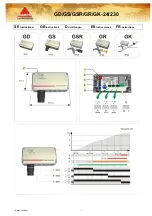
User Manual - PolyXeta
®
2 Detector with HL Sensor
for Refrigerant Gases - May_2020
Page
23
PolyXeta
is a registered trademark of MSR
Made in Germany
GAPX2_Freon_E_2020_05_18
Phone: +49 8531 9004-0 Fax: +49 8531 9004-54
Specification subject to change without notice
MSR-Electronic GmbH, Buergermeister-Schoenbauer-Str. 13, D 94060 Pocking
www.msr-electronic.de
10
Sensor Specification of Semi-conductors for Freon Gases
Semiconductor gas sensors (metal oxide sensors) are electrical conductivity sensors. The resistance of its
sensitive layer changes upon contact with the gas to be detected. The gas then reacts with the sensor
surface. This reaction is reversible in the ideal case. Due to their chemical properties metal oxide gas sensors
are suitable for a wide range of applications and the detection of all reactive gases. Depending on the
materials used and the gases to be detected, common operating temperatures in the semiconductor sensor
are between 300 °C and 900 °C. The signal is logarithmic to the gas concentration
–
not linear. The current is
evaluated by the subsequent measuring amplifier and converted into a linear output signal.
Oxidation processes lead by-and-by to an unwanted influence on the alteration of the conductivity.
Therefore, regular calibrations of zero-point (Zero) and gain are necessary (see section 8.4).
Certain substances and gases in the monitored ambient can affect the sensitivity of the sensor
element or destroy the sensor completely. This is called poisoning.
The following are currently known:
•
Polymerising substances, such as ethylene oxide, acrylonitrile, butadiene, styrene, silicone.
•
Catalytic poisons, such as sulphur and phosphor compounds, silicon compounds, metal vapours.
•
Organic solvents.
Semiconductor sensors are not linear on principle. This means that the sensor would only measure
accurately on the calibrated point and not over the entire measuring range. Therefore, a linearization is
included in our software to improve this behaviour. But since the sensor resistance of a semiconductor may
be very different (between 4 - 40 kOhm), it must be normalized. This can be done via the potentiometer.
Thus, the different output signals can be changed accordingly and adjusted appropriately.
Gas measured
Refrigerant & Freon Gases
Sensor element
Semi-conductor
Measuring range
See table 10.2
Temperature range
max. signal change (basis 20 °C)
-25 °C to +60 °C
± 5 % of range or ± 15 % of reading
Humidity range
max. signal change (basis 50 % RH)
20 to 90 % RH (not condensing)
± 5 % of range or ± 30 % of reading
Pressure range
max. signal change (basis 100 h Pa)
80 to 120 k Pa
± 5 % of range or ± 30 % of reading
Flow speed:
Incl. wind shield
max. signal change
0 to 3 m /s
Up to 6 m/s
± 5 % of range or ± 10 % of reading
Table 10.1: Maximum ambient conditions of sensors
















































